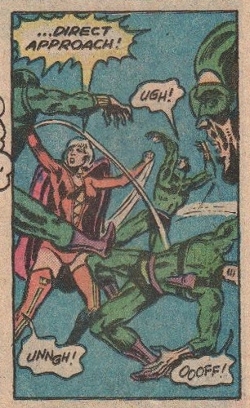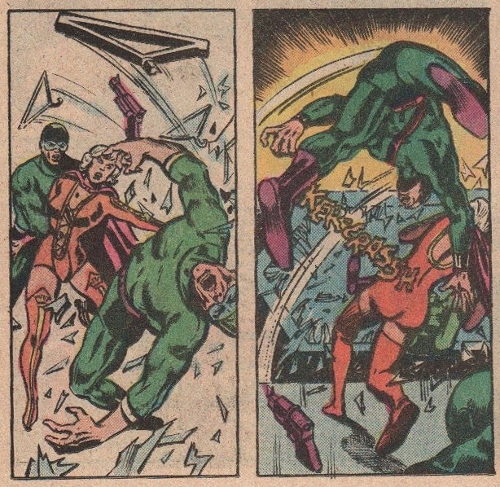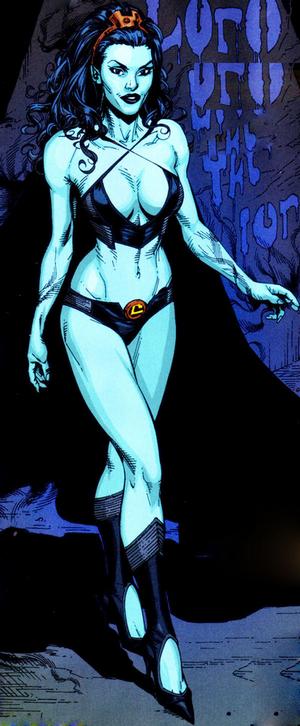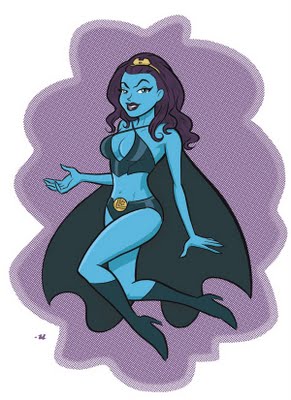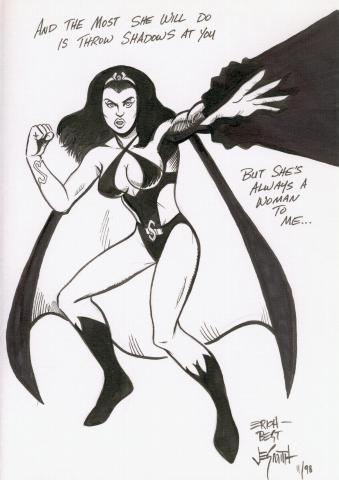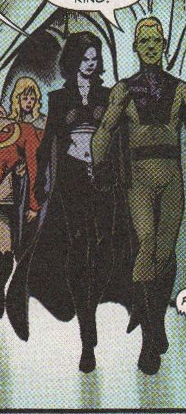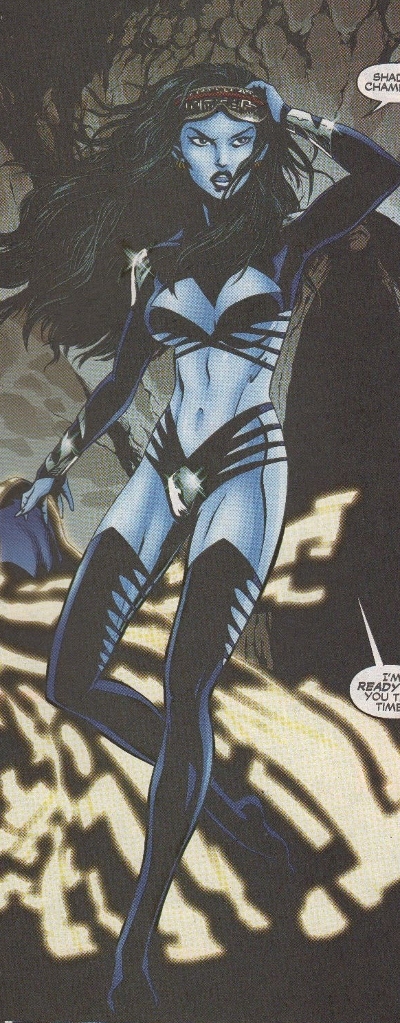Proper Prior Planning Prevents Poor Performance
The 1978 Iron Man story arc where Tony Stark reacts to the superhero
life by overindulging in alcohol is a generally well-written set of
stories. A glaring discontinuity is apparent though, in one of the
early issues where a guest penciller fills in for one issue. Bethany
Cabe is seen for the second time in the arc and she's presented as a
flirty airhead.
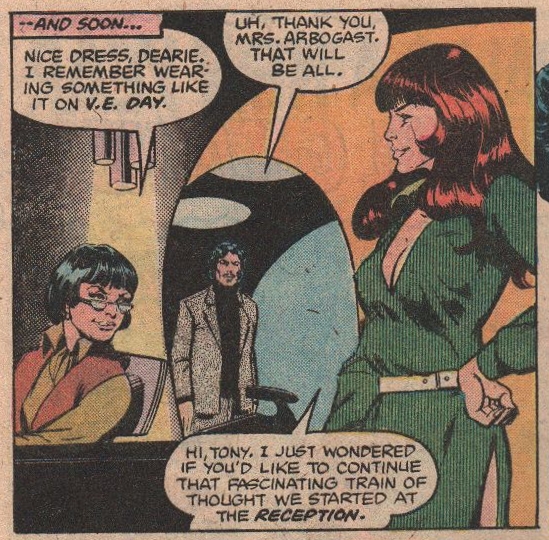

Rhodey, who becomes an important character later on, is seen as a chubby, mellow, laid-back working stiff.
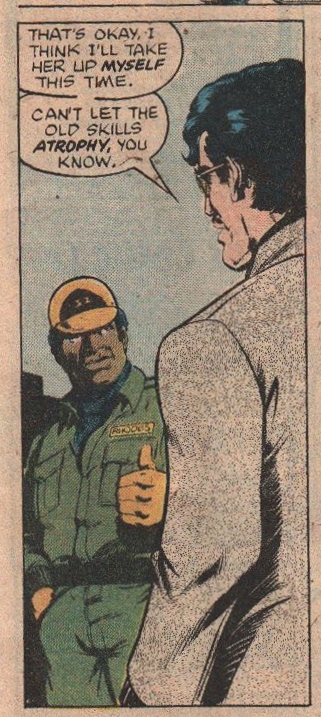
Two issues later, both characters are re-introduced. Bethany has gotten
much more serious and focused and Rhodey has slimmed down and gotten
serious as well.
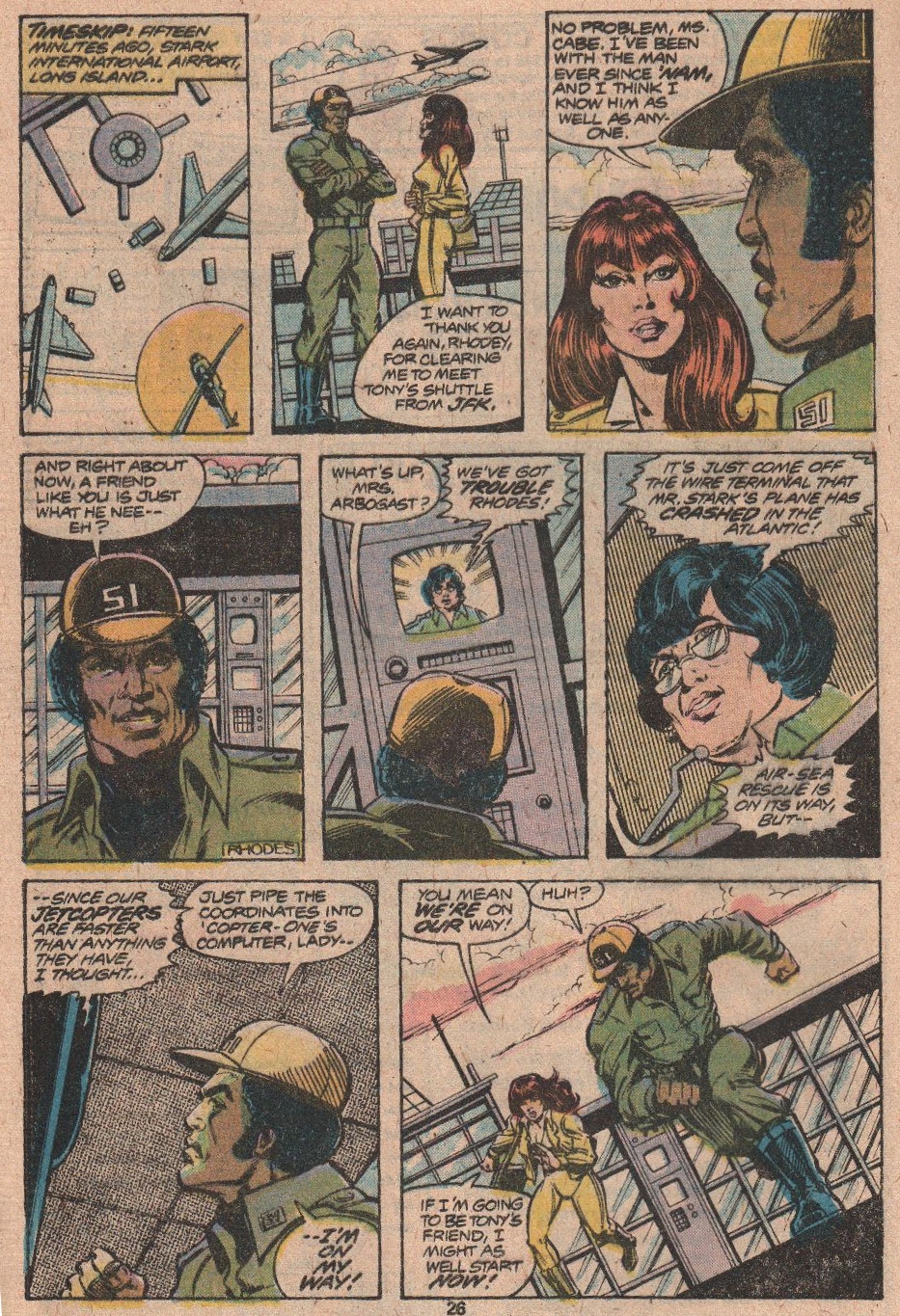
I blame the editors for goofs like this. Somebody just clearly wasn't
paying attention, didn't see to it that the fill-in artist was properly
briefed on the storyline and permitted these inconsistencies to appear.
And yeah, this next page, where Tony has been tossed out of the SHIELD
helicarrier from many thousands of feet up, is really dramatic and well
drawn, but there's a bit of a problem here.
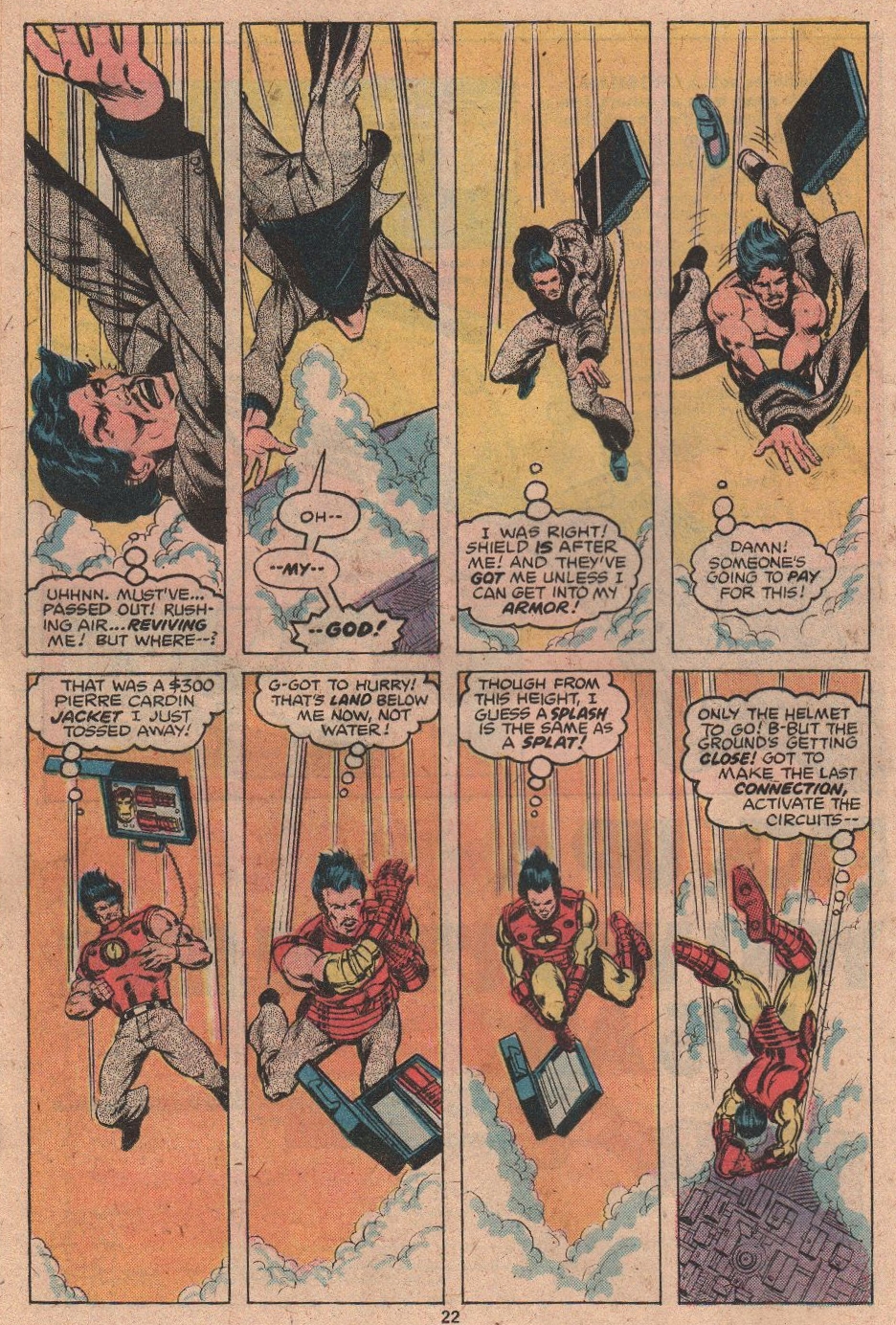
Erm, how exactly did Tony get his "$300 Pierre Cardin jacket" over the
suitcase that's clearly handcuffed to his wrist? Hmm, maybe he did a
fast disconnect-reconnect to allow the jacket to slip off? Ah well,
that might
probably just fall under "willing suspension of disbelief," as it's
necesary to the story that Tony remains handcuffed to his suitcase as
otherwise he might not be able to do his mid-air change (He got his
armor on and got it activated just in time to avoid being splattered
all over the town that he was over).
------------------
As to the lack of editorship on the Conan the Barbarian series, one particular item I noticed upon
a new Editor-in-Chief taking over at Marvel Comics was that Conan would often have as
many as three titles, one previewed in the prior issue, one on the
cover and one on the first page. With better editorship came single titles that would be used consistently in all three places.
The storyline where Conan spends time on a pirate ship
with Belit. the "Queen of the Black Coast," was one where I picked up
most of the issues, but was never really all that impressed by them and
after reading this review in The
Comics Journal #50 (1978), decided to dispose of them all. It annoyed
me to have wasted my time on a sub-standard storyline. As TCJ
pointed out, the story didn't even count as an arc as it was too
aimless and meandering for that. Over the course of almost 50 issues,
Belit got
captured and had to be rescued three separate times, Conan and Belit
fought each other under the influence of sorcery three, perhaps four,
times, Belit acted more like a spoiled brat than a pirate queen and was
never supplied with any believable motivations.
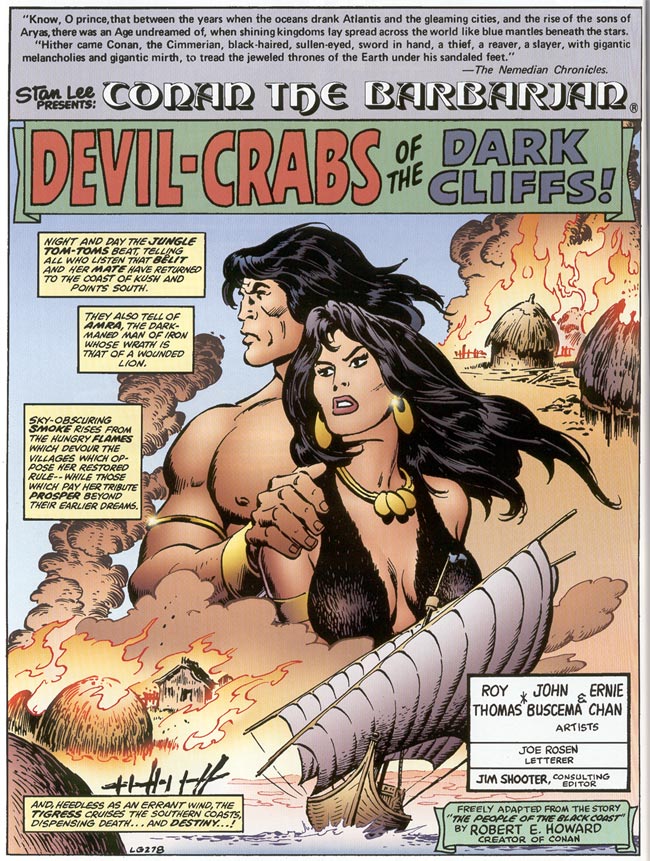
It was hard to believe that she led the pirates under her command with
any skill or competence prior to Conan's appearance on the scene. It
was also pretty hard to see what Conan's attraction to her was. I don't
remember any times when they simply relaxed and enjoyed each other's
company. Of course, in order to have a contrast to their usual sailing
about, the two of them would have to
have been supplied with a believable motivation to begin with, some
actual purpose for sailing around on the seas. They were clearly
competent enough fighters that they could have filled their ship with
treasure and retired long before their story ended. Conan was pretty
spectacularly written
at times, especially in the early years when it was drawn by Barry Smith, but in the Belit years, it was pretty forgettable.
The current series
is a breath of fresh air as this new Belit comes across as entirely
believable love interest of Conan's and as a skilled and competent
pirate captain. The 2012 Conan spends more time talking with a crew
member over the course of a single page than the 1970s Conan did over
the course of almost 50 issues. I don't believe the 1970s Conan or
Belit ever even referred to any of the crew members by their name.
The three series Swamp Thing, Sandman and the Sandman spin-off Lucifer
were all distinguished, for the better, by the fact that they were all
conceived as limited series. The 1970s Conan, along with just about all
the other comics at the time, were written to be forever-and-ever
stories where we saw a lot of filling of pages and dragging out of
stories just to make it to issue #100 or some other milestone. With the
Swamp Thing
under the writer Alan Moore, the series went from 1982 to 1985 and then
ended, meaning that the series was always jam-packed with fresh and
interesting storylines. The series never felt like it was simply
marking time or fillng up pages. The writer Neil Gaiman wrote Sandman from 1989 to 1996 and helped to start up Lucifer (Heavily based on the John Milton book Paradise Lost),
which was written by Mike Carey and ran from 2000 to 2006. In all three
cases, the series' were full and interesting and never had the "filler"
feel that the 1970s Conan often had.
---------------
Here's another 1978 work that really annoyed me. This is from Superboy
and the Legion of Superheroes #242. Now, I have to admit that the
terminology that Light Lass uses here bothers me much more during my
post-military career than it did before I was sensitive to the language
here, but the four superheroines in this story are not "on leave,"
they're "on liberty.'
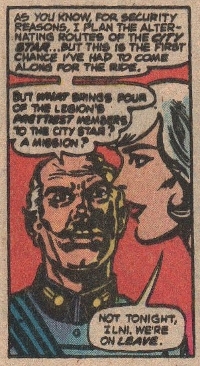
Being on leave normally means you're not available to your unit for at
least 24 hours and frequently, you're geographically outside your usual
place of duty for at least a few days. The superheroines are merely out
for the evening (The story is called "Girls' Night Out")
and have every intention of mustering as usual the next morning. Yeah,
okay, that's a fussy objection and I doubt that I noticed it at the
time.
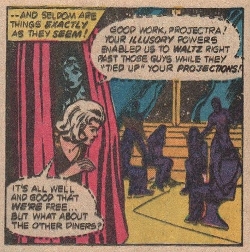
Whuuh?!?!?! The bad guys tied up a bunch of projections?!?!?! Princess Projectra's powers are visual,
she doesn't have the ability to project solid-feeling images. If she
had any such power, she wouldn't need to engage in straight-up
fistfighting as she does below.
Plus which, y'know, these villainous henchmen are all pretty buff,
capable-looking dudes. None of them look weak enough to be thrown
around like they do here, yet she handles them all without even
breaking a sweat. That might make sense if we saw the superheroines at
the beginning of the stoy emerging from the gym after a tough workout
and they commiserated with each other about how hard they had to work
to keep in shape and to keep their fighting skills sharp. As it is,
this amazing ninja-babe type fighting ability just comes, unexplained,
out of the blue.
Here, in a story two years later, Shadow Lass explains her powers:
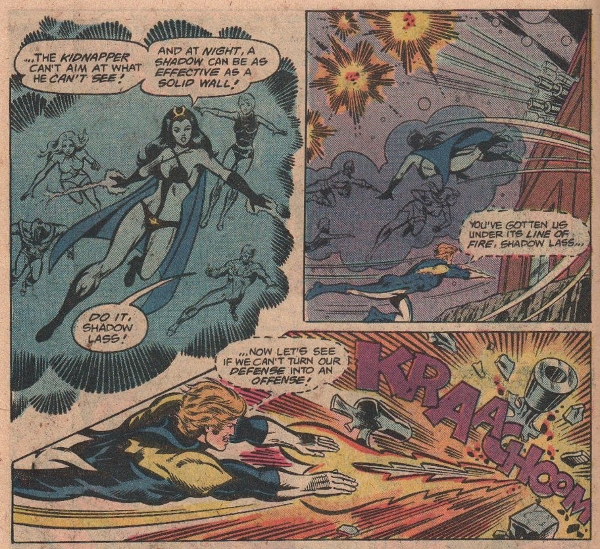
As with Princess Projectra, Shadow Lass' powers are purely visual. But here in the Girls' Night Out story, Shadow Lass engages in incredible physical feats:
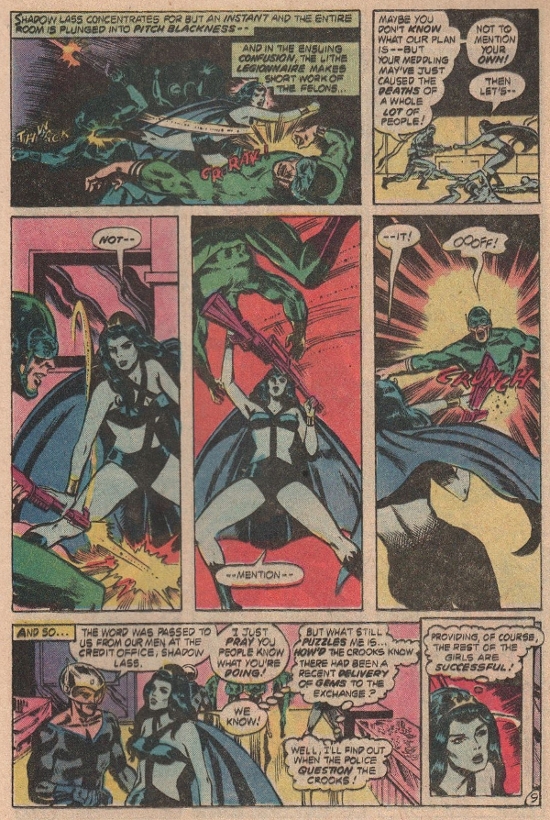
I guess it's not out of the question that this character could, without
any special super-powered fighting abilities, smack and throw around
the bad guy as though he were just a rag doll, but it's not terribly
believable.
I can certainly understand that this is a back-up story in a giant-size
issue and the writer was probably told at the last minute "Yo, we need
a 14-page story [Out of a 35-page issue] and we wanna make the females
look really powerful and capable." Of course, Shadow Lass was
introduced in 1968 and they just weren't coming up with a lot of tough,
capable superheroines at that point. The writer didn't have a lot of
leeway to soup up the female characters so that they could do awesome
stuff. But as I said earlier, the writer could have spent some time
explaining how the women were receiving special training and how they
were all seriously in awesome shape. The whole story just annoyed me
because they crudely tried to make these characters something that they
weren't.
Now, Shadow Lass or Umbra or "Shady" (Yes, all six of the above
pictures are of the same character), given much better writers in later
years, never had her powers upgraded, but became a much more
sympathetic
and respectable character. Princess Projectra, on the other hand,
fell
on hard times after being deposed from her position as a princess, became a villainness and
made a very energetic and a pretty successful run at destroying the
Legion.
----------
The Werewolf story (1973) starts off in a satisfactory manner. A
trucker notices the Werewolf's shadowy figure among the trucks.
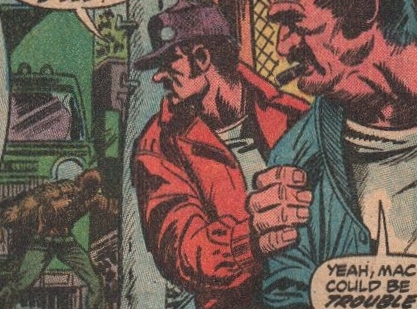
The truckers are entirely justified in going after our protagonist
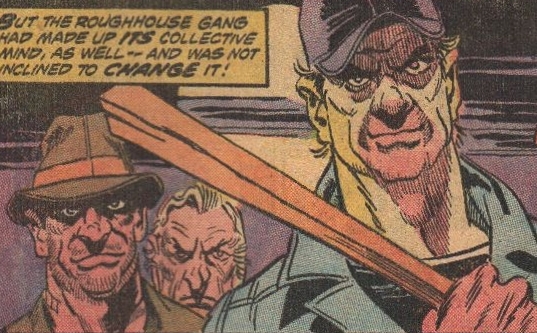
but they're clearly going to enjoy themselves WAY too much!
After a lot of in-the-dark scuffling...
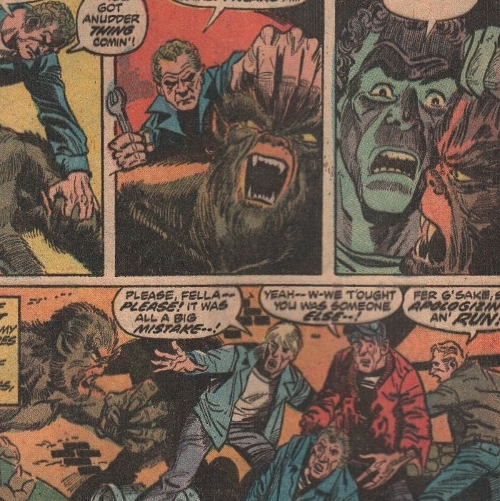
the truckers finally get a good look at who they were beating up. It
wouldn't have been justified for the truckers to have gotten badly hurt
and they weren't. They just got a good scare out of it all.
Our hero and the Werewolf's alter ego, Jack Russell, goes to the circus with his sister Lissa and her boyfriend Buck.
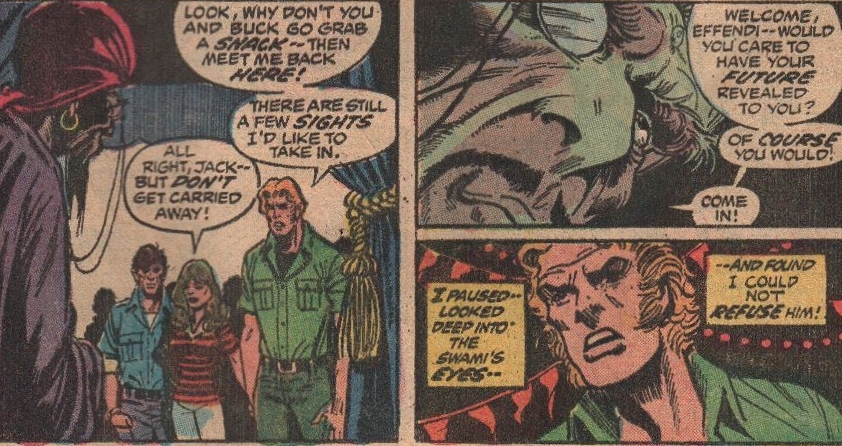
Jack quickly falls under the Swami Rhiva's spell and never regains full
consciousness for the remainder of the story. The Werewolf is fully
conscious, but only has the rather-limited intelligence of a wolf.
We're introduced to two other characters, Elmo & Mige.
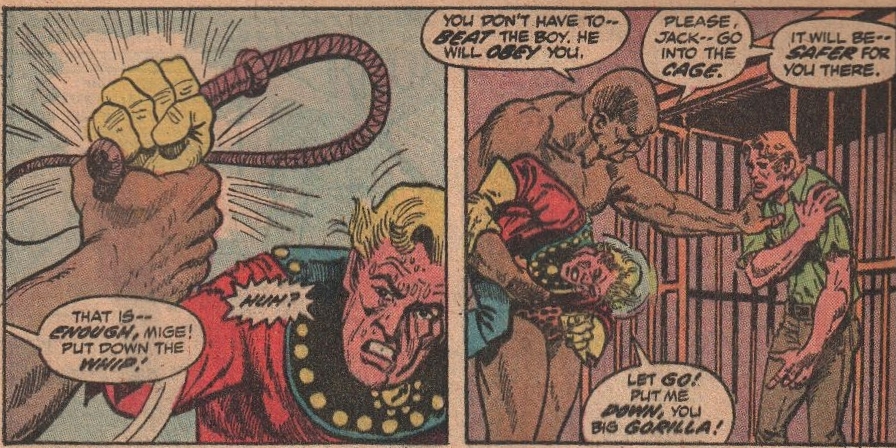
Elmo restrains Mige and protects Jack.
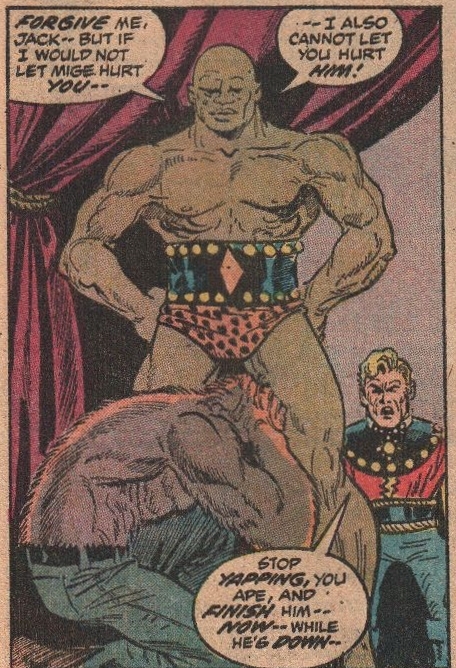
But Elmo proves to be an equal-opportunity protector, rescuing Mige from the Werewolf.
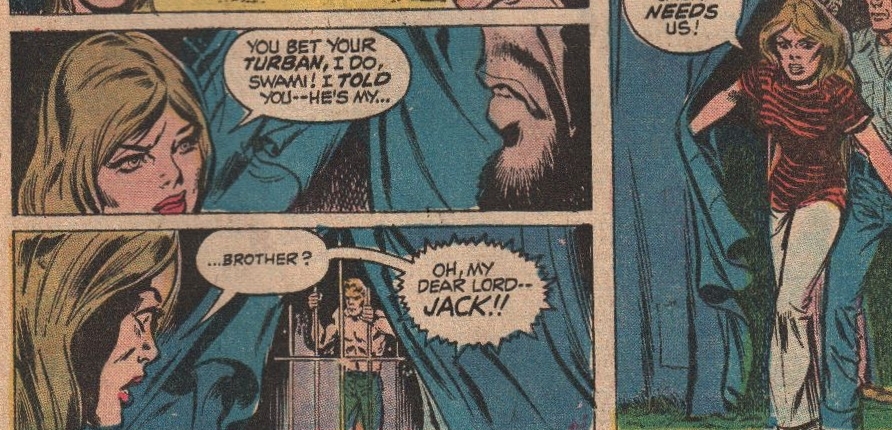
Jack's sister returns and questions Rhiva and discovers Jack in a state of stupor.
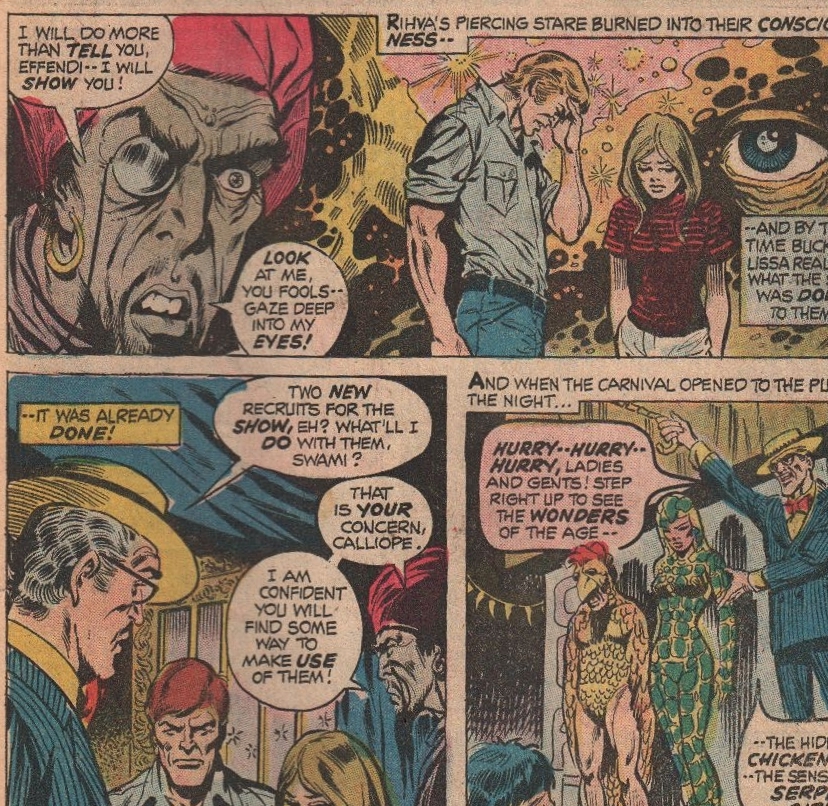
Buck and Lissa also fall under Rhiva's spell and become the chicken-man and the serpent-girl.
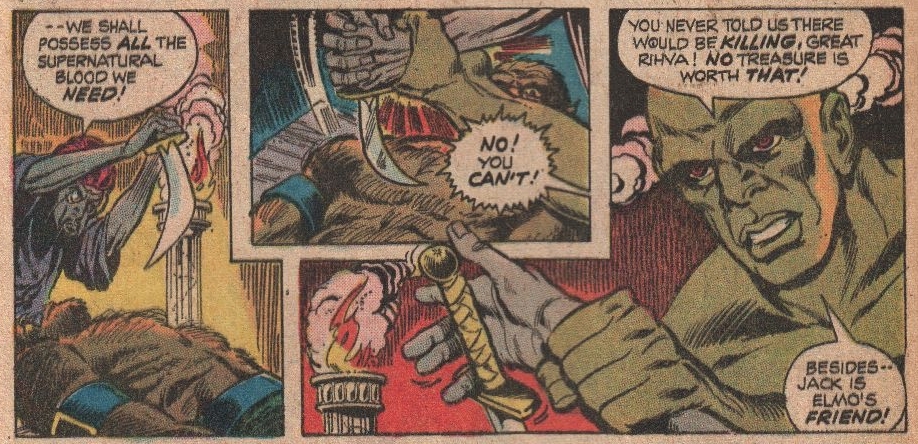
So here's my problem with this story. The good guys, Jack, Lissa and
Buck are all taken out of commission and the Werewolf is easily
handled, so Elmo, a fellow who's officially on the side of the bad
guys, turns out to be insubordinate and disrespectful towards his
senior people and refuses to obey orders. This makes for what I felt
was an unsatisfying ending as the heroes did nothing to save themselves
but were instead dependent on one of the bad guys turning on his own
side for their survival. Rhiva, Elmo and Mige all die, saving our
heroes the trouble of dealing with their welfare and Jack/The Werewolf,
Lissa and Buck all escape without difficulty. No exactly objectionable,
but unsatisfying.
Now HERE'S how to deal wtth employees who won't take instructions!
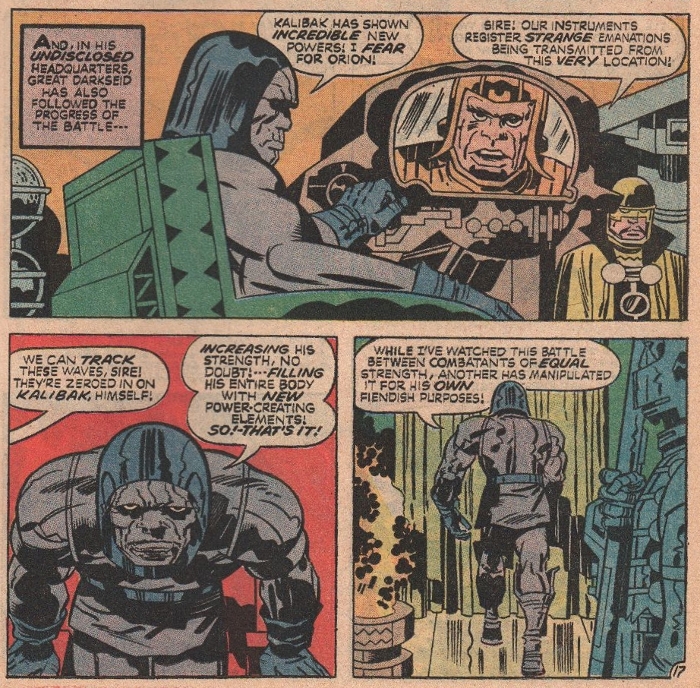
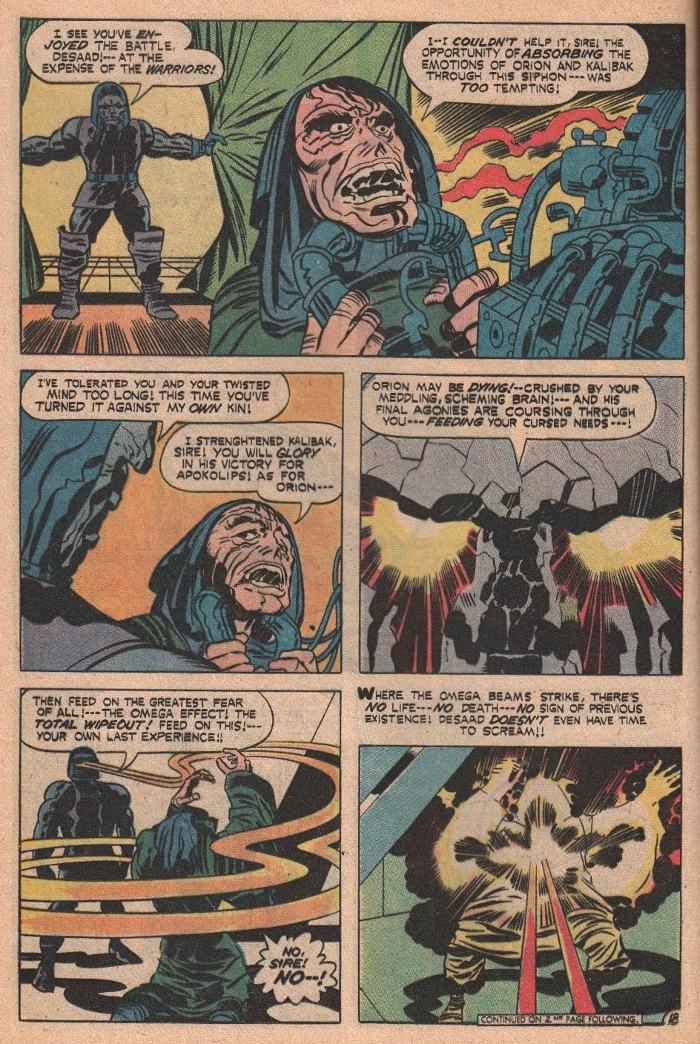
That's what I'M talkin' 'bout!
Home
